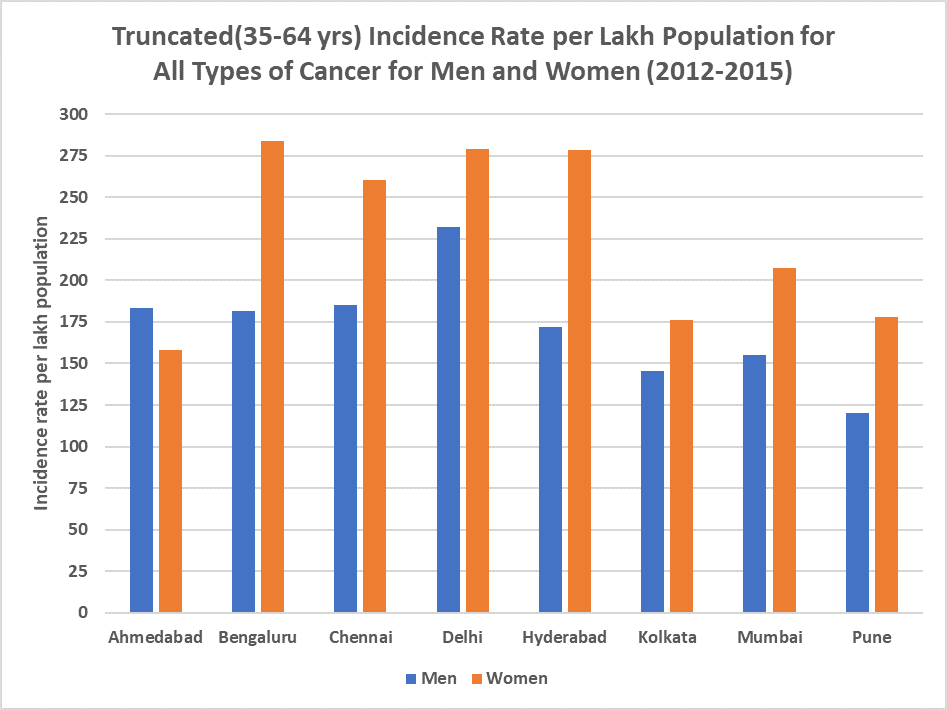The National Centre for Disease Informatics and Research (NCDIR), which is a unit of the Indian Council of Medical Research (ICMR) published the 2020 reports of the National Cancel Registry Program (NCRP). These reports are published for major cities in the different zones of India and provide details about cancer incidence in these cities.
The details provided include the prevalence of different types of cancers across different age groups and genders, the incidence of cancer in the population (number of cases per 100,000 people), and the methods that helped diagnose these cancers. They provide valuable information to not only understand which cancers are affecting which cities and age groups more, but also where the gaps in diagnosis are.
One of the important parameters is the incidence rate per 100,000 in the population for different types of cancers. The incidence rate is calculated as total number of cases divided by the total population being considered and multiplied by 100,000. For instance, if for 50 Lakh males, 1000 cases of throat cancer were recorded, the incidence rate is ((1000/5,000,000) * 100,000), which gives a rate of 20 cases for every 100,000 people.
For a given population the incidence rate tells you which types of cancer are more prevalent and helps you target prevention and diagnosis at that population level. The NCDIR report gives the truncated incidence rates (TR) for men and women separately for different cities, for the age-group 35-64 years, and for 55 different groups of cancer.
The Truncated rate is important as it identifies the incidence of cancer in people who are in an age-group that can be considered prime, when they are expected to be working and part of the workforce. Even though the median age at which people contract cancer would likely be towards the higher end of the range rather than lower, it gives a picture of the burden of cancer borne by the working population. As people age and cross into their 70s, the report shows that incidence as well as types of cancer starts increasing, especially for men.
Cancer incidence in men in major cities of India
Five major types of cancer are predominant among men in the 8 major cities considered in the 35-64 years age group based on the TR. They are cancers of the lung, mouth, tongue, stomach and oesophagus. However, among the cities considered there is a lot of variation in terms of rate and which types of cancer are more prevalent among these.

Cancers of the lung, mouth and tongue are the predominant types of cancers in men among most Indian cities. Bengaluru and Chennai are the only cities to buck this trend, where stomach cancer is seen more than in other cities. Bengaluru has a much lower prevalence of mouth and tongue cancers and much higher rates for cancers of the stomach and oesophagus.
Lung cancer is among the top 3 cancers in every major Indian city. Among the cities, Delhi and Kolkata record the highest rates for this type of cancer, followed by Bengaluru, Chennai and Hyderabad. Pollution and smoking are among the major causes for lung cancer.
Oral cancers – mouth and tongue are also among the top 3 in every city except Bengaluru and Chennai. Among the cities, Ahmedabad has the highest rates for both types of cancer. In fact, among the cities considered, Ahmedabad’s rate of 47.5 per lakh for mouth cancer is the highest rate for any type of cancer in men. One of the main causes for mouth and tongue cancers is chewing tobacco in the form of pan masala and ghutka. Any intervention to reduce the burden of oral cancers in the population will have to take that into consideration.

In terms of total incidence rate for all types of cancer among men, Delhi clearly stands out from the rest, followed by Ahmedabad, Bengaluru, Chennai and Hyderabad.
Cancer incidence in women in major cities of India
For women, the story is different when it comes to cancer incidence. Instead of the five types seen in men, there are three major types that are predominant amongst women in the 35-64 years age group. They are cancers of the breast, cervix uteri and ovary. The incidence rates are also much higher than what is seen in men for these cancers.

While the highest recorded cancer rate was 47.5 for mouth cancers for men in Ahmedabad, the rates for breast cancer in women are mostly above 70. Breast cancer is the most common form of cancer among women followed by cancers of the cervix and uteri, and of the ovary. The highest rate is recorded in Hyderabad followed by Chennai, Bengaluru and Delhi. For cancers of the cervix and uteri, the highest rate recorded is in Bengaluru followed by Chennai and Delhi.

Bengaluru, Chennai, Delhi and Hyderabad record more than 250 per lakh population in total incidence rates for all types of cancer for women, followed by Mumbai at over 200. Ahmedabad is the lowest at just over 150.
In our cities what can be seen from the total truncated incidence rates is that women are at a much higher risk of cancer than men in the age group considered.

Women in cities like Bengaluru, Chennai and Hyderabad, have a 50% higher risk of cancer than men on average. In Delhi, the difference between men and women is less only because the incidence rate for men is higher than in other cities, driven primarily by higher lung cancer rates. Increased exposure to high pollution levels is likely the culprit here. Ahmedabad is the only city that bucks the trend with men showing a higher risk of cancer. The extremely high rate of mouth cancer is the main reason for that.
You can find the reports here.

